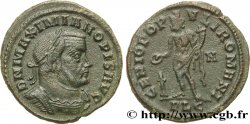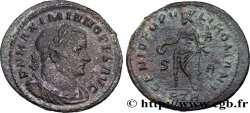brm_458496 - MAXIMIANUS HERCULIUS Demi-follis ou demi-nummus
Not available.
Item sold on our e-shop (2018)
Price : 150.00 €
Item sold on our e-shop (2018)
Price : 150.00 €
Type : Demi-follis ou demi-nummus
Date: 308
Mint name / Town : Alexandria
Metal : copper
Diameter : 21 mm
Orientation dies : 6 h.
Weight : 3,48 g.
Rarity : R2
Officine: 1re
Coments on the condition:
Bel exemplaire pour ce type avec notamment un très beau revers. Patine marron
Predigree :
Exemplaire au pedigree prestigieux, provenant de la collection Dattari, vendue le 9 mars 2017, lot 3361
Obverse
Obverse legend : D N MAXIMIANO FELICISSIM.
Obverse description : Buste lauré consulaire de Maximien Hercule à droite, vu de trois quarts en avant, avec la trabea, tenant une branche d'olivier de la main droite et la mappa de la main gauche (H*5).
Obverse translation : "Domino Nostro Maximiano Felicissimo", (À notre seigneur le plus heureux Maximien).
Reverse
Reverse legend : PROVIDENTIA DEORVM/ A// ALE.
Reverse description : Providentia (la Providence) et Quies (le Repos) debout face à face. La Providence est debout à gauche tournée à droite, drapée, levant la main droite. Le Repos est debout à droite tourné à gauche, tenant une branche de laurier de la main droite et un sceptre long de la main gauche.
Reverse translation : "Providentia Deorum Quies Augustorum", (La Providence divine et le repos des augustes).








 Report a mistake
Report a mistake Print the page
Print the page Share my selection
Share my selection Ask a question
Ask a question Consign / sell
Consign / sell
 Full data
Full data



